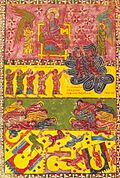Spanish art
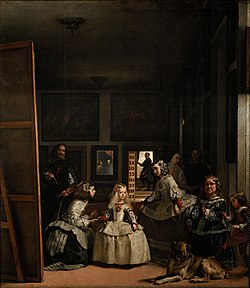
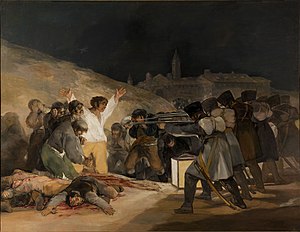
Spanish art has been an important contributor to
The
Meanwhile, the parts of Spain remaining Christian, or that were
Spanish Baroque architecture has survived in large quantity, and has both strains marked by exuberant extravagance, as in the Churrigueresque style, and a rather severe classicism, as in the work of Juan de Herrera. It was generally the former which marked the emerging art and Spanish Colonial architecture of the Spanish Empire outside Europe, as in Latin America (New Spanish Baroque and Andean Baroque), while the Baroque Churches of the Philippines are simpler. The decline of the Habsburg monarchy brought this period to an end, and Spanish art in the 18th and early-19th century was generally less exciting, with the huge exception of Francisco Goya. The rest of 19th-century Spanish art followed European trends, generally at a conservative pace, until the Catalan movement of Modernisme, which initially was more a form of Art Nouveau. Picasso dominates Spanish Modernism in the usual English sense, but Juan Gris, Salvador Dalí and Joan Miró are other leading figures.
Ancient Iberia

The early
As elsewhere in the Western Empire, the Roman occupation largely overwhelmed native styles; Iberia was an important agricultural area for the Romans, and the elite acquired vast estates producing
-
The Treasure of Villena, perhaps 10th century BC
-
Elx, Valencian Community, 4th century BC
Early Medieval

The Christianized
The jewelled
Muslim and Mozarab Spain
The extraordinary palace-city of
The Pisa Griffin is the largest known Islamic sculpture of an animal, and the most spectacular of a group of such figures from Al-Andalus, many made to hold up the basins of fountains (as at the Alhambra), or in smaller cases as perfume-burners and the like.
The Christian population of Muslim Spain (the Mozarabs) developed a style of
Hispano-Moresque ware pottery began in the south, presumably mainly for local markets, but Muslim potters were later encouraged to migrate to the Valencia region, where the Christian lords marketed their luxury lustrewares to elites all over Christian Europe in the 14th and 15th centuries, including the Popes and the English court. Spanish Islamic ivory carving and textiles were also very fine; the continuing industries producing tiles and carpets in the peninsula owe their origins largely to the Islamic kingdoms.[11]
After the expulsion of the Islamic rulers during the
-
IvoryMedina Azahara, 968
-
Page from the Morgan Beatus
-
Mediciarms, 1450–1460
Painting
Romanesque
In Spain, the art of the
Gothic
The Gothic art of Spain represented a gradual development from previous Romanesque styles, being led by external models, first from France, and then later from Italy. Another distinctive aspect was the incorporation of
Early Renaissance
Due to important economic and political links between Spain and Flanders from the mid-15th century onwards, the early Renaissance in Spain was heavily influenced by Netherlandish painting, leading to the identification of a Hispano-Flemish school of painters. Leading exponents included Fernando Gallego, Bartolomé Bermejo, Pedro Berruguete and Juan de Flandes.
Renaissance and Mannerism

Overall the Renaissance and subsequent Mannerist styles are hard to categorise in Spain, due to the mix of Flemish and Italian influences, and regional variations.[16]
The main centre for Italian Renaissance influence entering Spain was
Elsewhere in Spain, the influence of the Italian Renaissance was less pure, with a relatively superficial use of techniques that were combined with preceding Flemish practices and incorporated
Golden Age
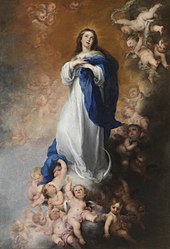
The
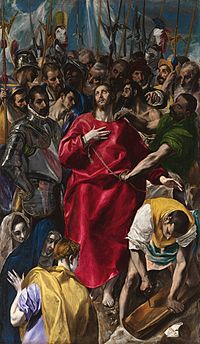
Although mostly active in Italy, particularly in Naples,
Being the gateway to the New World, Seville became the cultural centre of Spain in the 16th Century, and attracted artists from across Europe, drawn by lure of commissions for the growing empire, and for the numerous religious houses of the wealthy city.[29] Starting from a strongly Flemish tradition of detailed and smooth brushwork, as revealed in the works of Francisco Pacheco (1564–1642), over time a more naturalistic approach developed, with the influence of Juan de Roelas (c. 1560–1624) and Francisco Herrera the Elder (1590–1654). This more naturalistic approach, influenced by Caravaggio, became predominant in Seville, and formed the training background of three Golden Age masters: Cano, Zurbarán and Velázquez.[30]
Francisco de Zurbarán (1598–1664) is known for the forceful, realistic use of chiaroscuro in his religious paintings and still lifes. Although seen as limited in his development, and struggling to handle complex scenes. Zurbarán's great ability to evoke religious feelings made him very successful in receiving commissions in conservative Counter-Reformation Seville.[31]
Sharing the same painting master – Francisco Pacheco – as Velázquez,
Velázquez
Diego Velázquez (1599–1660) was the leading artist in the court of King Philip IV. In addition to numerous renditions of scenes of historical and cultural significance, he created scores of portraits of the Spanish royal family, other notable European figures, and commoners. In many portraits, Velázquez gave a dignified quality to less fortunate members of society like beggars and dwarfs. In contrast to these portraits, the gods and goddesses of Velázquez tend to be portrayed as common people, without divine characteristics. Besides the forty portraits of Philip by Velázquez, he painted portraits of other members of the royal family, including princes, infantas (princesses), and queens.[33]
Later Baroque
Later Baroque elements were introduced as a foreign influence, through visits to Spain by
The pre-eminent painter of the period – and most famous Spanish painter prior to the 19th century appreciation of Velázquez, Zurbarán and El Greco – was
18th century

The beginning of the
Restricted from royal sponsorship, many Spanish painters continued the Baroque style in religious compositions. This was true of
Continuing in the Spanish still life tradition of Sánchez Cotán and Zurbarán, Meléndez produced a series of cabinet paintings, commissioned by the Prince of Asturias, the future King Charles IV, intended to show the full range of edible foods from Spain. Rather than being merely formal studies in Natural History, he used stark lighting, low viewpoints and severe compositions to dramatise the subjects. He showed great interest and attention to the details of reflections, textures and highlights (such the highlight on the patterned vase in Still Life with Oranges, Jars, and Boxes of Sweets) reflecting the new spirit of the age of Enlightenment.[42]
Goya
Francisco Goya was a portraitist and court painter to the Spanish Crown, a chronicler of history, and, in his unofficial work, a revolutionary and a visionary. Goya painted the Spanish royal family, including Charles IV of Spain and Ferdinand VII. His themes range from merry festivals for tapestry, draft cartoons, to scenes of war, fighting and corpses. In his early stage, he painted draft cartoons as templates for tapestries and focused on scenes from everyday life with vivid colors. During his lifetime, Goya also made several series of grabados, etchings which depicted the decadence of society and the horrors of war. His most famous painting series are the Black Paintings, painted at the end of his life. This series features works that are obscure in both color and meaning, producing uneasiness and shock.
He is considered the most important Spanish artist of late 18th and early 19th centuries and throughout his long career was a commentator and chronicler of his era. Immensely successful in his lifetime, Goya is often referred to as both the last of the Old Masters and the first of the moderns.
19th century
Various art movements of the 19th Century influenced Spanish artists, largely through them undertaking training in foreign capitals, particularly in Paris and Rome. In this way
Early years were still dominated by the

The later part of the century saw a strong period of Romanticism represented in history paintings, as in the works of
Joaquín Sorolla (1863–1923) excelled in the dexterous representation of the people and landscape under the sunlight of his native land, thus reflecting the spirit of Impressionism in many paintings, particularly his famous seaside paintings. In Children on the beach he makes the reflections, shadows and gloss of the water and skin his true subject. The composition is very daring, with the horizon omitted, one of the boys cut off, and strong diagonals leading to the contrasts and increased saturation of the upper-left of the work.[47]
20th century


During the first half of 20th century many leading Spanish artists were working in Paris, where they contributed to – and sometimes led – developments in the
Joan Miró was also closely associated with the Surrealists in Paris, who particularly approved of his use of automatism in composition and execution, designed to expose the subconscious mind.[53] Although his later and more popular paintings are refined, whimsical and apparently effortless, his influential period in the 1920s and 1930s produced works that were provocative in their sexual symbolism and imagery, and employing rough, experimental materials, including sandpaper, unsized canvases, and collage.[54] In mature period painting, La Leçon de Ski, his characteristic language of signs, figures and black linear forms against more textured and painterly background is evident.
Ignacio Zuloaga and José Gutiérrez Solana were other significant painters of the first half of 20th century.
Post WW2
In the post-War period, the Catalan artist Antoni Tàpies became famous for his abstract works, many of which use very thick textures and the incorporation of non-standard materials and objects. Tàpies has won several international awards for his works.[55]
Sculpture


The Plateresque style extended from beginnings of the 16th century until the last third of the century and its stylistic influence pervaded the works of all great Spanish artists of the time. Alonso Berruguete (sculptor, painter and architect) is called the "Prince of Spanish sculpture" because of the grandeur, originality, and expressiveness achieved in his works. His main works were the upper stalls of the choir of the
Other notable sculptors were

Another period of Spanish Renaissance sculpture, the Baroque, encompassed the last years of the 16th century and extended into the 17th century until reaching its final flowering the 18th, developing a truly Spanish school and style, of sculpture, more realistic, intimate and independently creative than that of the previous one which was tied to European trends, especially those of the Netherlands and Italy. There were two Schools of special flair and talent: the Seville School, to which Juan Martínez Montañés belonged (called the Sevillian Fidias), whose most celebrated works are the Crucifix in the Cathedral of Seville, another in Vergara, and a Saint John; and the Granada School, to which Alonso Cano belonged, to whom an Immaculate Conception and a Virgin of Rosary, are attributed.
Another notable Andalusian Baroque sculptors were
The Valladolid school of the 17th century (Gregorio Fernández, Francisco del Rincón) was succeeded in the 18th century, although with less brilliance, by the Madrid School, and it was soon transformed into a purely academic style by the middle of the century. In turn, the Andalusian school was replaced by that of Murcia, epitomised in the person of Francisco Salzillo, during the first half of the century. This last sculptor is distinguished by the originality, fluidity, and dynamic treatment of his works, even in those representations of great tragedy. More than 1,800 works are attributed to him, the most famous products of his hand being the Holy Week floats (pasos) in Murcia, most notable amongst which are those of the Agony in the Garden and the Kiss of Judas.
In the 20th century the most important Spanish sculptors were Julio González, Pablo Gargallo, Eduardo Chillida and Pablo Serrano.
Spanish collectors and museums of art
The
The
Other artistic disciplines
- Architecture
- Cinematography
- Music
References
- ^ some are as old as 40,800 years old, according to "U-series dating of Paleolithic art in 11 caves in Spain", Science, 2012 Jun 15 ;336(6087):1409–1413.
- ^ Gudiol, 10–11
- ^ Gudiol, 11–12
- ^ Gudiol, 13–21
- ^ Gudiol, 21–28
- ^ The first R is held at the Musée de Cluny, Paris.
- ^ Gudiol, 29-33
- ^ Gudiol, 59-61
- ^ Gudiol, 34–42, 47–51
- ^ Gudiol, 53–59, 86
- ^ Gudiol, 43–44, 51–52
- ^ Gudiol, 188–197
- ^ Walter W. S. Cook, Romanesque Spanish Mural Painting from The Art Bulletin, Vol. 11, No.4, Dec 1929, accessed from JSTOR: [1]
- ^ The Prado Guide, pg. 48
- ^ Prado Guide, p. 28
- ^ Prado Guide, p. 42
- ^ Prado Guide, p. 38
- ^ Prado Guide, p. 42
- ^ Prado Guide, p. 42
- ^ The Prado Guide, pg. 48
- ^ Jonathan Brown, The Golden Age of Painting in Spain. New Haven: Yale University Press 1991.
- ^ José Antonio Maravall, Culture of the Baroque: Analysis of a Historical Structure. Minneapolis MN 1986.
- ^ Prado Guide, pg 64
- ^ Prado Guide, pg 74
- ^ Prado Guide, pg 66
- ^ Prado Guide, pg 54
- ^ Prado Guide, pg 60
- ^ Prado Guide, pg 76, 79
- ^ Prado Guide, pg 84
- ^ Prado Guide, pg 84
- ^ Prado Guide, pg 84
- ^ Prado Guide, pg 90
- ^ Jonathan Brown, Velázquez: Painter and Courtier. New Haven: Yale University Press 1986.
- ^ Prado Guide, p. 132-139
- ^ Prado Guide, p. 140
- ^ Prado Guide, p. 141
- ^ Prado Guide, p. 147
- ^ Prado Guide, p. 148
- ^ Prado Guide, p. 150–151
- ^ Prado Guide, p. 152–153
- ^ Prado Guide, p. 157
- ^ Prado Guide, p. 154-155
- ^ Prado Guide, pp. 196, 202
- ^ Prado Guide, pp. 196-200
- ^ Prado Guide, p.208
- ^ Prado Guide, p. 210
- ^ Prado Guide, pp. 217
- ^ Haftmann, pg 191
- ^ Haftmann, pg 80
- ^ From Rubin Dada, Surrealism and Their Heritage pg. 111 (quoted in Gardner, pg. 984)
- ^ Gardiner, pg. 984
- ^ Gardiner pg. 985. 1991
- ^ Gardiner, pg. 985
- ^ Jean-Hubert Martin, foreword of Joan Miró – Snail Woman Flower Star, pg. 7, Prestel, 2008
- ^ Tate website, quoting: Ronald Alley, Catalogue of the Tate Gallery's Collection of Modern Art other than Works by British Artists, Tate Gallery and Sotheby Parke-Bernet, London 1981, pp. 714–15
- ^ Santiago Alcolea Blanch, The Prado. New York: Harry N. Adams, Inc. 1996, p. 9.
- ^ Alcolea Blanch, The Prado, p. 10.
- ^ Alcolea Blanch, The Prado, pp. 10–11.
- ^ Alcolea Blanch, The Prado, p. 15.
Further reading
- Alcolea Blanch, Santiago. The Prado. Translated from the Spanish by Richard-Lewis Rees and Angela Patricia Hall. New York: Harry N. Abrams, Inc. Publishers 1991.
- The Art of medieval Spain, A.D. 500-1200. New York: The Metropolitan Museum of Art. 1993. ISBN 0870996851.
- Berg Sobré, Judith. Behind the Altar Table: The Development of the Painted Retablo in Spain, 1350-1500. Columbia, Miss. 1989.
- Brown, Jonathan, Painting in Spain, 1500-1700 (Pelican History of Art), Yale University Press, 1998, ISBN 0300064748
- Dodds, Jerrilynn D. (ed.) Al-Andalus: The Art of Islamic Spain. New York 1992.
- Gardner's: Art Through The Ages - International Edition, Brace Harcourt Jovanovich, 9th Edn. 1991
- Gudiol, José, The Arts of Spain, 1964, Thames and Hudson
- Jiménez Blanco, María Dolores, ed. The Prado Guide, Madrid: Museo National del Prado, English 2nd Revised Edition, 2009
- McDonald, Mark (2012). Renaissance to Goya : prints and drawings from Spain. London: The British Museum. ISBN 9780714126807.
- Moffitt, John F. The Arts in Spain. London: Thames & Hudson 1999.ISBN 0-500-20315-6
- O'Neill, John P. (ed.), The Art of Medieval Spain, AD 500-1200. New York 1993.
- Palol, Pedro and Max Hirmer. Early Medieval Art in Spain. New York 1966.
- Sánchez Pérez, Alfonso E. (1992). Jusepe de Ribera, 1591-1652. ISBN 9780870996474. (full text resource that contains information on Ribera as well as a number of other Spanish artists)
- Tomlinson, Janis, From El Greco to Goya: Painting in Spain 1561–1828, Abrams Art History, 1997
- Williams, John. Early Spanish Manuscript Illumination. New York 1977.
- Young, Eric. Bartolomé Bermejo: The Great Hispano-Flemish Master. London 1975.
External links
 Media related to Art in Spain at Wikimedia Commons
Media related to Art in Spain at Wikimedia Commons





